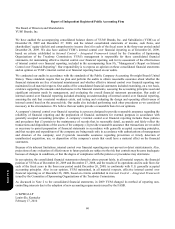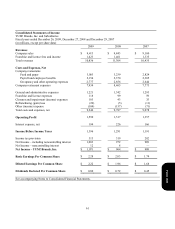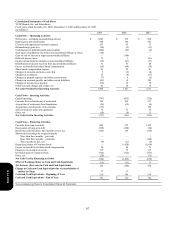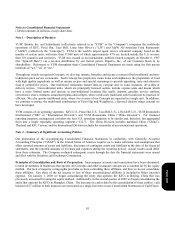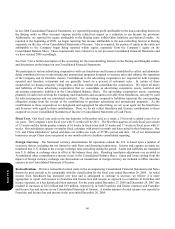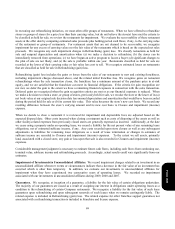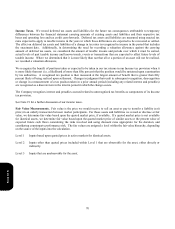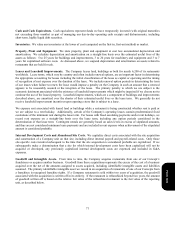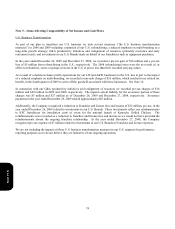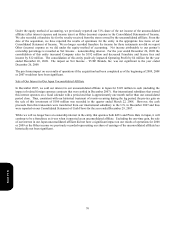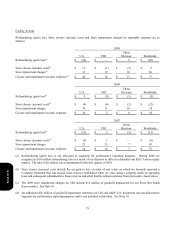Pizza Hut 2009 Annual Report Download - page 160
Download and view the complete annual report
Please find page 160 of the 2009 Pizza Hut annual report below. You can navigate through the pages in the report by either clicking on the pages listed below, or by using the keyword search tool below to find specific information within the annual report.
69
In executing our refranchising initiatives, we most often offer groups of restaurants. When we have offered to refranchise
stores or groups of stores for a price less than their carrying value, but do not believe the store(s) have met the criteria to
be classified as held for sale, we review the restaurants for impairment. We evaluate the recoverability of these restaurant
assets at the offer date by comparing estimated sales proceeds plus holding period cash flows, if any, to the carrying value
of the restaurant or group of restaurants. For restaurant assets that are not deemed to be recoverable, we recognize
impairment for any excess of carrying value over the fair value of the restaurants which is based on the expected net sales
proceeds. We recognize any such impairment charges in Refranchising (gain) loss. We classify restaurants as held for
sale and suspend depreciation and amortization when (a) we make a decision to refranchise; (b) the stores can be
immediately removed from operations; (c) we have begun an active program to locate a buyer; (d) significant changes to
the plan of sale are not likely; and (e) the sale is probable within one year. Restaurants classified as held for sale are
recorded at the lower of their carrying value or fair value less cost to sell. We recognize estimated losses on restaurants
that are classified as held for sale in Refranchising (gain) loss.
Refranchising (gain) loss includes the gains or losses from the sales of our restaurants to new and existing franchisees,
including impairment charges discussed above, and the related initial franchise fees. We recognize gains on restaurant
refranchisings when the sale transaction closes, the franchisee has a minimum amount of the purchase price in at-risk
equity, and we are satisfied that the franchisee can meet its financial obligations. If the criteria for gain recognition are
not met, we defer the gain to the extent we have a remaining financial exposure in connection with the sales transaction.
Deferred gains are recognized when the gain recognition criteria are met or as our financial exposure is reduced. When
we make a decision to retain a store, or group of stores, previously held for sale, we revalue the store at the lower of its (a)
net book value at our original sale decision date less normal depreciation and amortization that would have been recorded
during the period held for sale or (b) its current fair value. This value becomes the store’s new cost basis. We record any
resulting difference between the store’s carrying amount and its new cost basis to Closure and impairment (income)
expense.
When we decide to close a restaurant it is reviewed for impairment and depreciable lives are adjusted based on the
expected disposal date. Other costs incurred when closing a restaurant such as costs of disposing of the assets as well as
other facility-related expenses from previously closed stores are generally expensed as incurred. Additionally, at the date
we cease using a property under an operating lease, we record a liability for the net present value of any remaining lease
obligations, net of estimated sublease income, if any. Any costs recorded upon store closure as well as any subsequent
adjustments to liabilities for remaining lease obligations as a result of lease termination or changes in estimates of
sublease income are recorded in Closures and impairment (income) expenses. To the extent we sell assets, primarily
land, associated with a closed store, any gain or loss upon that sale is also recorded in Closures and impairment (income)
expenses.
Considerable management judgment is necessary to estimate future cash flows, including cash flows from continuing use,
terminal value, sublease income and refranchising proceeds. Accordingly, actual results could vary significantly from our
estimates.
Impairment of Investments in Unconsolidated Affiliates. We record impairment charges related to an investment in an
unconsolidated affiliate whenever events or circumstances indicate that a decrease in the fair value of an investment has
occurred which is other than temporary. In addition, we evaluate our investments in unconsolidated affiliates for
impairment when they have experienced two consecutive years of operating losses. We recorded no impairment
associated with our investments in unconsolidated affiliates during 2009, 2008 and 2007.
Guarantees. We recognize, at inception of a guarantee, a liability for the fair value of certain obligations undertaken.
The majority of our guarantees are issued as a result of assigning our interest in obligations under operating leases as a
condition to the refranchising of certain Company restaurants. We recognize a liability for the fair value of such lease
guarantees upon refranchising and upon subsequent renewals of such leases when we remain contingently liable. The
related expense is included in Refranchising (gain) loss. The related expense for other franchise support guarantees not
associated with a refranchising transaction is included in Franchise and license expense.
Form 10-K



